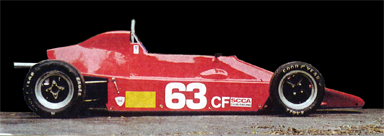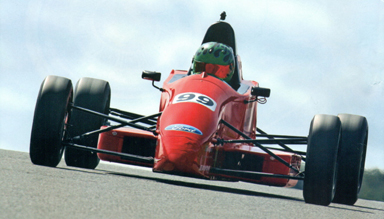Essays on Auto Racing
The Racing Car
Can a racing car be a beautiful object, stationary and silent as a sculpture? Many are, their sleek and balanced forms blending into the kind of whole often seen in well-configured mechanical devices - their dynamic shapes complemented by bold colors and by the fine finish on delicately formed metal and fiberglass pieces.
But the real aesthetic appeal of a pure racing car is derived from its singular, purposeful appearance, a confirmation of an obvious dedication to the achievement of special performance goals. Within the constraints of a given set of rules - or "formula", a racing car is designed to maximize the potential for speed. Its configuration is not fixed or final. Rather, the suspension and engine, the steering and "wings" or aerodynamics - can be adjusted to achieve desired characteristics.
Inevitably, racing cars embody some of the history and glory of earlier designs by making reference to long-admired and well proven forms of the great marques - Ferrari, Maserati, Miller, Bugatti and Lotus - in whose shops and foundries skilled designers and artisans created the shapes upon which all current racing car designs are based.
The racing car is a "machine" which signals its origins, its purpose, its singular intent and its special kind of refinement. It manifests the spirit and the aspirations of its builder, a spirit that also lives in those who ready the car for competition and in those who drive it at the limit, striving for victory.

Straights
At Watkins Glen, after the ninety-degree Turn One and a short, quick downhill chute, the cars make their way through the Esses, flat out up the hill – engines straining - and onto the two-thousand-foot straight. Accelerating the whole time, they ultimately reach close to one hundred twenty miles an hour before slowing for the Inner Loop, a quick, challenging right-left chicane.
Running alone or in a pack, there is a sense of unity with the car, a sense of pure speed, a magnificent feeling of freedom resulting from swift, straight movement along the road. The driver is focused on the forward motion and on a single goal - to try to gain some distance on the competition, to watch the other cars shrink in the mirror’s view.
If other speedy cars are alongside or surging out in front, they seem to move slowly and effortlessly as if participating in synchronized motion - a ballet danced to the music of mechanical sounds accompanied by the rush of the wind. Advantages are gained and lost as places are exchanged and running positions are sorted out over the length of the straight.
This exuberant experience is heightened by the increasing speed and by an awareness that the long straight leads to a turn where, at entry, the car must be slowed and guided through on a precise line, quickly transitioning from the ease and relative calm of the straight to the challenge and grace of prescribed movement through the curve.

Corners
In road racing, while pure straight-line speed has an unmistakable appeal, the corners are where a fast car, in slowing, changing direction and accelerating, exhibits its finest performance characteristics.
A racing car's complex components are designed to deliver high speeds through a curve as the car is guided along an ideal arc. On that path the driver is challenged to sense and reach the car's performance limits by feeling the car's balance and reacting to the dynamic forces of movement. The approach to a corner is necessarily fast and to achieve quick laps, momentum, through the turn and onto the straight that follows, is essential.
The timing - of braking, shifting gears and turning in - is the key to the smooth execution of this critical sequence. These dynamic transitions are really the essence of the racing experience and making them involves the skillful changing of speed and direction while on the very edge of adhesion; an edge that represents a fine line between control and chaos, a line the racing driver seeks to approach but not to cross. There, on that line, is found the thrill of fast, controlled movement, a feeling not unlike the excitement of downhill skiing.
The resulting sensation is what makes the whole unique experience so satisfying and exhilarating.